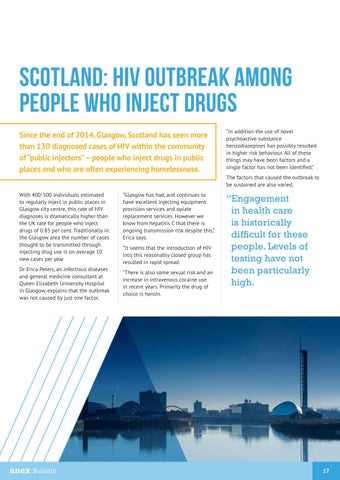Scotland: HIV outbreak among people who inject drugs Since the end of 2014, Glasgow, Scotland has seen more than 130 diagnosed cases of HIV within the community of “public injectors” – people who inject drugs in public places and who are often experiencing homelessness.
“In addition the use of novel psychoactive substance benzodiazepines has possibly resulted in higher risk behaviour. All of these things may have been factors and a single factor has not been identified.”
With 400-500 individuals estimated to regularly inject in public places in Glasgow city centre, this rate of HIV diagnoses is dramatically higher than the UK rate for people who inject drugs of 0.85 per cent. Traditionally in the Glasgow area the number of cases thought to be transmitted through injecting drug use is on average 10 new cases per year
“Engagement in health care is historically difficult for these people. Levels of testing have not been particularly high.
Dr Erica Peters, an infectious diseases and general medicine consultant at Queen Elizabeth University Hospital in Glasgow, explains that the outbreak was not caused by just one factor.
“Glasgow has had, and continues to have excellent injecting equipment provision services and opiate replacement services. However we know from hepatitis C that there is ongoing transmission risk despite this,” Erica says. “It seems that the introduction of HIV into this reasonably closed group has resulted in rapid spread. “There is also some sexual risk and an increase in intravenous cocaine use in recent years. Primarily the drug of choice is heroin.
The factors that caused the outbreak to be sustained are also varied.
17










